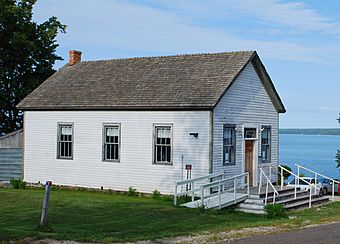Assinins, Michigan facts for kids
|
Assinins
|
|

House in Assinins
|
|
| Location | US 41, Assinins, Michigan |
|---|---|
| Architect | Fr. Frederic Baraga |
| NRHP reference No. | 72000591 |
Quick facts for kids Significant dates |
|
| Added to NRHP | May 19, 1972 |
Assinins (Ojibwe: Asiniinsikaajiigibiig) is a special place in Michigan with a lot of history! It's a historic district, which means it's an area with old buildings that are important because of their past. These buildings were once a school and an orphanage. Assinins is located in Michigan and was added to the National Register of Historic Places in 1972.
Contents
History of Assinins
Assinins was started in 1843 by a person named Bishop Frederic Baraga. He came to this area because Chief Edward Assinins invited him. Chief Assinins was the first person to be baptized (a Christian ceremony) at this spot.
The Old St. Joseph Orphanage
In 1860, Bishop Baraga built the Old St. Joseph Orphanage and School here. More parts were added to the building in 1866 and 1877. After the Civil War, Bishop Baraga gave the land and buildings to Chief Assinins and the Keweenaw band of the Chippewa Native Americans.
The orphanage was a home for both Native American and European children. Later, in 1929, a bigger orphanage was built on the same site. In 1957, the buildings were given a new purpose. They became the Sacred Heart Friary for the Capuchin Fathers, who used it as a place for new members to train until the late 1960s. After that, the site was used as the KBIC tribal center, but it was later taken down.
Why Assinins Is Important
The buildings at Assinins are very important because they were one of the first Catholic missions in the Upper Peninsula of Michigan. Bishop Frederic Baraga was closely connected to this mission. It helped create a good connection between the local Ottawa and Chippewa tribes and the settlers who were arriving from the east.
Bishop Baraga's Impact
Bishop Baraga helped the local tribes gain official recognition for their own self-governance. He also helped them buy land in their own names. This helped the tribe members become recognized citizens in the area. Some of the oldest buildings in the region are found at Assinins. Bishop Baraga also wrote some of his most famous books while he was staying in Assinins. These included a book about Chippewa grammar and a Chippewa dictionary.
What Assinins Looks Like Today
The Assinins site originally had many buildings. There were more than 15 log cabins spread out over about 500 acres (about 2 square kilometers). Today, the site has a school building, which is now used as a warehouse. It also has several buildings that were once part of the orphanage.
The biggest building is the Old St. Joseph Orphanage and School. It is three stories tall. It is built from "rubble," which means it's made from rough, broken stones. It has a gable roof with "dormers," which are windows that stick out from the sloped roof.
Close by, there is a cemetery. This cemetery is where several missionaries are buried. These include Father Gerhard Terhorst, Monsignor Melchior Faust, Father John Henn, and Father Anthony Vermare.
Images for kids





